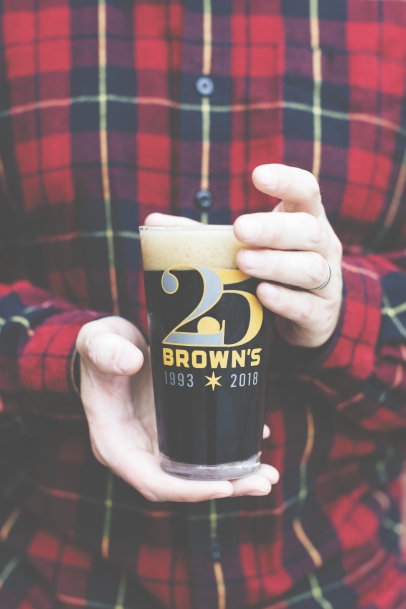Twenty-Five Years of Making Happier Hours for the Capital District
Garry and Kelly Brown introduced their first baby to the world on their wedding day. And while she’s grown up to be (almost) as stunning as her three older sisters, Abigail, 21, Nora, 19, Mageean, 15, she was pretty ugly at first glance, they admit.
But, like the happy, proud parents of an accolade-bearing Ivy League–bound child, after winning numerous awards (including a recent Gold in the prestigious 2018 New York State Craft Beer Competition for Brown’s barrel-aged sour Reprise), launching two taprooms with highly regarded restaurants in Troy and North Hoosick and decades of fiercely defended happy hours behind them, the Browns can laugh about their firstborn’s initially inauspicious debut.
“Garry was a serious home brewer but still just a hobbyist when we got married in May of 1990,” Kelly recalls. “He and brewing partner/ best man Jim Moran made a wedding feast ale in the closet of his apartment in Schenectady, and we were all so proud of it. We used it instead of Champagne for a more personal toast, but as I looked around the Canfield Casino later, most of the glasses were untouched since folks were apprehensive about cloudy looking beer.”
A home brew in 1990 would be regarded as, perhaps, a homemade cashew cheese would be today. Sure, it’s being done, and in 10 years, most people will probably have a packet of artisanally produced alt-cheese in their fridge, but only a few people would have the verve and audacity to serve, say, a caprese salad at their wedding with their homemade cashew cheese in lieu of the mozz.
For the first of many times in their brewing lives, the Browns were way ahead of the curve. While Sonoma’s New Albion Brewery’s brief existence (1976–1982) inspired a generation of home brewers, few had the capital or chutzpah to turn their closet keg habit into a full-blown business. In 1990, there were only 250 breweries in the U.S. (up from eight in 1980). Now, there are more than 6,000.
The Browns went pro just as the movement was beginning to toddle in 1993. “I knew enough about making beer to make it work, but not enough about life and business to be as nervous as I probably should have been,” Garry admits, exchanging a look of bemusement with Kelly.
I sat down with the Browns recently at their lovely 18th-century farmhouse to talk all things hops and malt, and toast to their 25 years in business. Their home is nestled in a hamlet of northern Rensselaer County, and while it’s just a short back-road meander to their new(ish) North Hoosick brewery, there are no superhighways in sight, nothing stitching the Browns—or their home, set on 200-plus acres—to anyone or anything they don’t purposefully invite in.
Yet, it’s immediately clear that their home has become a hub for the community. Neighbors (or what passes for neighbors in rural locales), farmers they source meat and produce from, friends of their girls, randoms like me, zip in and out of their relaxed but elegant home. When they do stay, it’s often to wander or rest by their gorgeous yard, a series of cultivated, symbiotic flower and vegetable patches, terraced perennial flower gardens, stone walls, fields of wildflowers, a duck family quacking away in their pond. It’s all hemmed in with a classic country stone wall and the gently sloping hills of fields that, seen through the rearview mirror of a car, look like they’re lifted out of a fairy tale.
Their home is to the Browns what their business is to the community. While they launched their brewing empire with a bracing brew of equal parts talent, smarts and naivety, it has been built on good old-fashioned hard work and a progressive vision of a business’s proper place in the community.
Brown’s Brewing Company was opened in 1993 as the Brown & Moran Brewing Company. The initial partners were Garry Brown and Jim Moran, along with restaurateur Peter Lindley, who soon left the business. Garry, then 32, and Kelly, who was 25 in 1993, had actually purchased the decrepit (but landmarked, per the National Register of Historic Places) space at 417 River Street in Troy in 1990. In 1991, the building was taken over by Garry’s parents, Sid and Doris Brown, who were able to invest in the real estate and actively participate in completing the facility over the next two years. The process of renovating the 150-year-old warehouse (which had been abandoned in 1980 after a fire and was full of detritus, pigeons and their prodigious produce), bringing it up to code and then securing the right permits to serve food and brews, was anything but the hilarity-filled kegger 20-somethings may envision when toying with the idea of launching a brewery.
But they knew, early on, that it was about more than just the beer.
“I grew up in Saratoga Springs, and the entire Capital District, the history, the farms, it means so much to me personally,” Kelly says. (Garry is a native of Schenectady.) “We both really wanted to make an impact on the region as a whole with our business, partner with local farmers whenever we could, get involved in initiatives that invigorate the business community without endangering the rural landscape.”
As the first brewery restaurant in the Capital Region since Prohibition, the opening of Brown’s helped initiate the revitalization of the City of Troy, which has become, arguably, ground zero for the region’s culinary excellence, representing a range of cultures and cuisines (from the stunning American farm-to-table creations at Peck’s Arcade to the next-level Korean cuisine at Sunhee’s Farm and Kitchen).
“We were blessed with more business than we could handle from the get-go,” Garry recalls of the hectic early days. “We were understaffed and the staff we had was undertrained. We learned fast. Trial by fire.”
Garry and Kelly spent the first 10 years in business building on the foundation of their early explosive success and filing away at the rough edges revealed by their propulsive blastoff. They initially started with only five beers on tap, but that number grew as they promoted Peter Martin, originally a barback, up the chain of command to director of brewing.
Tragically, Martin died suddenly at age 45 at his home in Hoosick last July.
“He was like a member of the family,” Garry says, as Kelly nods her head. “He was with us every step of the way during our growth. I miss him every day.”
For Garry and Kelly, there really is no talk of work-life balance. Work is their life, and some of their co-workers now feel more like kin. With that in mind, the Browns, while eager to grow, have been extraordinarily cautious, because so much—more than money—is at stake. They’re the reluctant swimmers who first play at the water’s edge, watching, until finally they dip their toes in, rethink, reconsider, reflect. But once they’re in, you can’t get them out.
In 2004, the Browns were ready to share their brews with a wider circle. They started by hand-filling 22-ounce bottles. Two years later, they bought a machine that filled 24 bottles per minute. Then it was a machine that could fill 75 bottles in a minute. They chugged along, distributing first around the state, then to Vermont and Massachusetts. They’re headed to Rhode Island next, and from there? They’ll see.
The most serious leap they’ve taken, though, is in the recent opening of a 20,000-barrel production brewery in North Hoosick to brew, can and keg beer for broader distribution. (In Troy, they maxed out at 2,800 barrels.) They tackled yet another historic structure, this one erected in 1854 on the edge of Walloomsac River. They purchased the factory and its 48 acres in 2009, did a major rehab and officially opened its doors in 2013, and welcomed eaters and drinkers to its taproom and brewery in fall of 2014.
“We brew in both places, but in North Hoosick, it’s focused on packaging, and in Troy, it’s focused on experimentation,” Garry says. “Our two brewers in Troy have a mandate to experiment. Last year, they made more than 100 variations on different styles, many of which sold out immediately, some of which may turn into something more.”
And while the Browns could go big-business if they wanted to—last year, Brown’s spent $1.7 million to add a canning line in North Hoosick—they won’t, unless it’s on their terms.
“It’s essential that we support our community,” Kelly says. “In Troy, we just updated our menu so we could focus more on seasonality and locally produced meats, dairy and produce.”
That goes for the grain and hop farmers, too, though there are challenges in terms of quality and price. “I love that grain and hop farming is being revitalized in New York, and we support that as much as we can,” Garry says. “I’ve seen the quality of locally grown grains and hops go up signifi cantly in the past few years, and the price has stabilized. But there are still challenges, especially in terms of consistency and quantity. If I get 30 pounds of hops from a farmer in New York, that may account for his or her entire crop, but that barely puts a dent in what I need. We’re getting there, though.”
Revitalizing the local economy (twice), check. Lifting up local farmers (again and again … and again), check. Defending happy hour (always), check. What’s next?
“Power,” Garry says. “Hydropower. Our North Hoosick facility on the edge of Walloomsac River and a dam just above us used to provide hydropower here.” Garry and Kelly, biding their time and, as always, growing organically, will get there eventually.
Until then, go grab one of their sours (the Apricot Hop Tart, please) and a grass-fed cheeseburger, check out the view of the waterfall from their taproom on the Walloomsac and drink to 25 delicious years of beers, community and family, kin or not.
To 25 Years
Brown’s Brewing Company now gets 250,000 visitors every year between its two locations.
In 1993, Brown’s produced 350 barrels. Last year, they produced 10,000.
There are four core styles: Cherry Razz (6.5% ABV), Oatmeal Stout (5.2% ABV), Coast-to-Coast IPA (6.25% ABV), Krüsh Golden Lager (5.25% ABV).
In addition to the core four, Brown’s has six rotating series and styles. They include:
Hashtag Series of New England IPAs (The New England–style IPA series features a different expression of hops commanding a different hashtag name for each release: #suchtaste, #bikes, #getmoney.)
Wild Ale Series (with options like Terra, an American-blended wild conditioned on cabernet sauvignon grape juice, 8% ABV)
Basement Sessions Series (with creations like the gold medal–winning Reprise, a 6% ABV golden sour ale with honey, vanilla and chamomile)
Pilot brews from their experimental brewhouse in Troy (with small-batchers like Argyle Extra Pale Ale, a light traditional pale brewed from locally sourced Argyle Craft Malts and Hops/Cascade hops, 5% ABV)
Triad IPA Series, exploring the interplay between a trio of hop varieties using the same yeast strain and malt bill (like Triad IPA v.1 with Citra, Cascade and Hallertau Blanc, 7% ABV)
Brewer’s Reserve Sour Series, a line of barrel-aged sour beers featuring unconventional ingredients (like Brewer’s Reserve #5, a blend of four base beers, fermented and aged in oak, conditioned on grapefruit juice, zest, three types of mint, 6% ABV)
Sour Series (with suds like Apricot Hop Tart, a sour aged on apricots and dry-hopped with Amarillo)
In 2010, Brown’s took over Revolution Hall and turned it into a private event venue.
Last year alone, Brown’s has cranked out more than 100 types of beers, many of which were small-batch.
All told, Brown’s employs about 150 people, 50 of whom are full-time.
Brown’s Brewing Company | @brownsbrewingco
Peck’s Arcade | @pecksarcade
Sunhee’s Farm and Kitchen
Brown's Revolution Hall






